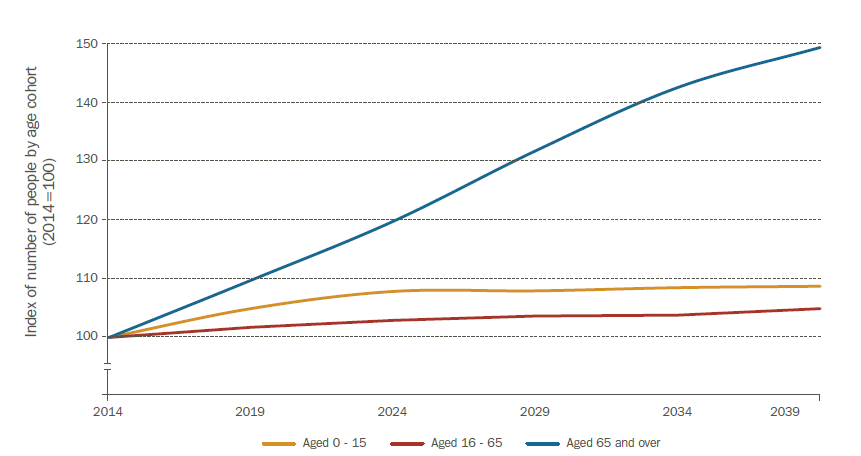I recently presented at Lichfields' Newcastle Breakfast Seminar on the topic of elderly care accommodation. Or, as I have seen termed elsewhere, accommodation for those in their “extended middle age!”.
The older population, elderly people, those in their extended middle age, however termed, is growing. Indeed, the number of people aged 65 or over in England is projected to increase more than any other age cohort in future years.
Figure 1: Population projections by age cohort, England (2014=100)

Source: ONS, Lichfields analysis
As previously reported by
Lichfields, this projection has wide-ranging implications as the country’s demographic profile is the foundation on which public finances are determined and major policy decisions are made. Another of the key implications of the population profile changing so markedly is that housing needs will change too.
In the same way that national policy is clear that local planning authorities (LPAs) must meet the housing needs of their local area, both for market and affordable housing (NPPF para 47), national policy is also clear that LPAs must meet the housing needs of different population groups, including older people (NPPF para 159). However, whilst the focus has been on building more houses in general (and rightly so), interventions have largely been concentrated on those at the start of their “housing career” (such as Starter Homes, First Time Buyer ISAs and so on). Significantly less focus has been placed on those in the later stages of their so-called “housing career”.
This is evident from the
Housing White Paper[1] which, in seeking to “fix our broken housing market” sets out some key targets, including:
- 225,000+ new homes to be provided per year (pg 9)
- 200,000 people brought into home ownership (para 4.21)
- 225,000 affordable homes to be built (para 4.26).
Yet there is no such target for meeting the needs of the older population. Rather, the Housing White Paper simply defers the issue, setting out the following:
Offering older people a better choice of accommodation can help them to live independently for longer and help reduce costs to the social care and health systems. […] To ensure that there is more consistent delivery of accessible housing, the Government is introducing a new statutory duty through the Neighbourhood Planning Bill on the Secretary of State to produce guidance for local planning authorities on how their local development documents should meet the housing needs of older and disabled people.
Para 4.42.
Whilst not tackling the issue head on, what the Housing White Paper does is reiterate the thrust of the NPPF - now in its fifth year – i.e. that LPAs are expected to have clear policies for addressing the housing needs and requirements of different groups, including older people. That said, some clear recognition of the severity of the current situation and an emphasis on the urgency required in introducing measures to start to address it would have been welcome.
This begs the question: do LPAs currently have clear policies for addressing the housing needs and requirements of older people? And in short, the answer is no.
Lichfields has analysed the 99 post-NPPF adopted Local Plans identified in its
Planned and Deliver Of these:
- 29 do not have a generic elderly persons’ accommodation policy;
- 88 do not have a specific requirement for elderly accommodation; and
- 94 do not make specific allocations.
It’s a ticking time bomb.
As an industry, in both public and private sectors, we need to ensure that we understand, through robust evidence, what the housing need is for the growing ageing population. Alongside this, we need to understand what supply is currently available. Only then can we formulate clear strategies on how the residual need could be met.
To help evidence the need and in order to understand the opportunities to deliver housing for the ageing population, Lichfields has produced its
Carepacity Toolkit.
Carepacity can assist in the planning process by:
- objectively assessing the need for housing for older people and finding potential development sites;
- understanding existing supply;
- assessing the potential of development sites;
- supporting the planning case by quantifying the range of benefits arising from the development of housing to meet the needs of the ageing population; and
- enabling delivery through an understanding of the planning and financial implications of different typologies of elderly care provision, as summarised below.
Figure 2: Typologies of accommodation
Source: Lichfields analysis
To discuss Carepacity further, please get in touch:
nye@lichfields.uk
[1] Department for Communities and Local Government - Fixing our broken housing market (February 2017)





